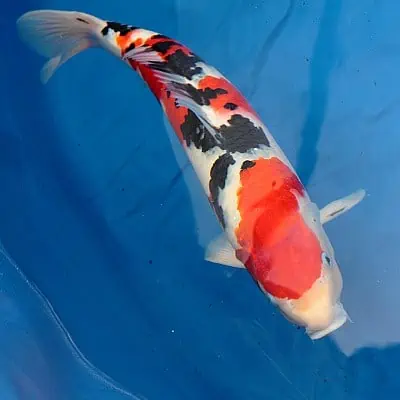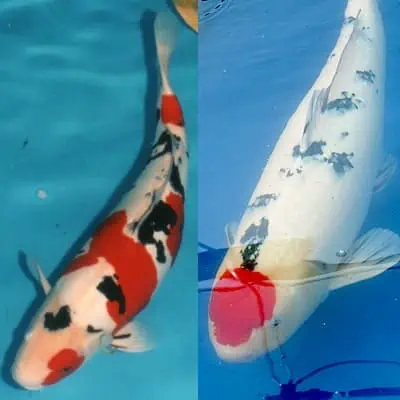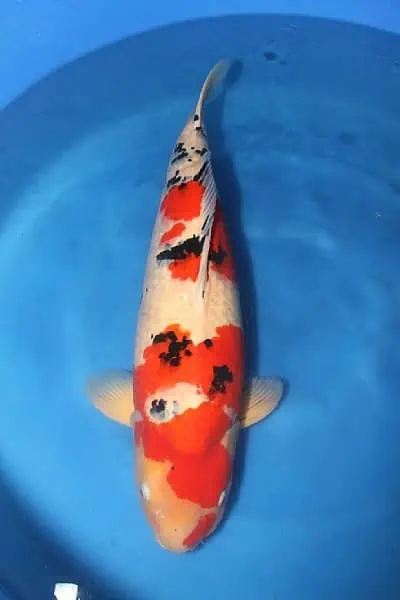
Modern koi carp breeding practices originated in China and Japan around the 4th century, meaning that koi have been around for thousands of years. In fact, mtDNA sequencing supports the commonly held belief that koi are descendants of the common carp (Cyprinus carpio), which the sequencing found originated in East Asia. This idea was previously highly contested, and still sometimes argued despite mounting evidence.
Since the 4th century (301 to 400 AD), koi have experienced an explosion in the number of breeds, patterns, and colorations available thanks to the aquaculture industry. In fact, the aforementioned DNA studies were also able to pinpoint that the large scale domestication of carp and subsequent breeding of them to obtain brightly colored varieties and unique patterns occurred in China beginning around 6,000 B.C.
These colorful, specially bred carp came to be known as “koi,” and were most often gifted to those with political and economic power as a gesture of good will and peace. This is how they initially made their way to Europe and, eventually, the Americas, becoming beloved pets rather than symbols of power and wealth.
Taisho Sanshoku koi, commonly known as Sanke, first arose from a (harmless) genetic mutation in the late 1800’s and began being bred in the 1910’s during the Taisho Emperor’s rule, giving rise to this popular breed’s name. Known as one of the “big three” along with Kohaku and Showa, Sanke koi are a well-loved, staple koi variety. Their striking red and white coloration with black accent patterning, called Sumi, make them a visual treat with plenty of variation possibility.
What does Taisho Sanshoku Mean?

This fish’s full name, Taisho Sanshoku, has a couple of meanings. Taisho was the name of Japan’s emperor at the time when Taisho Sanshoku were first purposely bred. Sanshoku breaks down into “san,” Japanese for “three,” and “shoku” means “colors,” so this refers to the koi’s white, red, and black coloring. Sanke is simply the abbreviated name for these koi, and is what they’re most often called.
- Max; Suction Depth: 7 Ft
- Suction Hose Length: 16 Ft
- Discharge Hose Length: 8 Ft, Max; Flow Rate: 1300 Gph
Sanke Varieties & How to Identify Them

Though all Sanke must possess porcelain-like white skin (called Shiro) with red to red-orange markings (Hi) atop it and some form of Sumi patterning, there are many different varieties of Sanke that encompass various types of patterns and arrangements. Sanke should not have any Sumi on their heads – koi with black on their heads are typically known as Showa koi, not Sanke.
Varieties According to Markings on the Body
1) Aka Sanke
Aka Sanke have a baseline straight-hi Kohaku pattern, meaning that the majority of their head and back are covered by red. The Sumi can exist anywhere on the body.
2) Tsubo (Subo) Sumi
Tsubo Sumi Sanke have black markings that only exist on white portions of the koi. There can be Hi (red) coloration, but the Sumi cannot be within these red portions.
3) Nidan
Meaning “two” in Japanese, Nidan consists of two patches of red, sometimes called “stepping stones,” that are not connected. Typically, one island is located toward the head or base of the head, while the other is closer to the tail. Sometimes, a koi is considered Nidan if the islands are on opposite sides of the dorsal fins, though this is less commonly accepted. The Sumi markings can exist anywhere on the back, whether on a red or white background.
4) Sandan
Translating to “three” in Japanese, Sandan Sanke means that the koi has three islands of red that are not connected. These must be located dorsally running from the tail to the head. Again, Sumi can exist anywhere dorsally on the body.
5) Yondan
Continuing with our theme, Yondon means “four” in Japanese, and is the same as the previous two classifications but, of course, with four disconnected patches of red running dorsally. Again, Sumi patterns can be anywhere on the dorsal portion of the body, regardless of whether they’re on the Hi plates or Shiro plates.
6) Doitsu
Doitsu Sanke can be any of the above (or combination thereof), except they are Doitsu. This means that the koi actually lacks scales, aside from some broad scales along their lateral line and dorsal fin.
Varieties According to Markings on the Head
1) Tancho
Meaning “red sun,” Tancho Sanke have a single red marking atop their head, with white on the rest of the body. Black markings typically exist only on the white body. No red exists on the body, and no black should be on the head (particularly not within the red spot).
2) Kuchibeni
Often referred to as the “lipstick” pattern, Kuchibeni koi have red markings around their mouth. Red can encompass the entire mouth, or just part of it, with Sumi markings existing on the body.
3) Menkaburi
Translating approximately to “face mask” or “hooded head,” Menkaburi koi have a large red patch that covers the top of their head like a hood. The red must extend below and behind the eyes to part of the neck, and may also reach the mouth. Sanke Menkaburi can have Sumi markings on the Hi or Shiro plates.
4) Maruten
The translation for Maruten is a bit rough, but koi with this pattern have a red spot on the head that is called a “crown.” There are also other red patches on the rest of the body, with variable patterning. The characteristic black patterning of Sanke koi can be found anywhere on the back, on red or white plates.
How to Appreciate & Judge Sanke Koi

The judging of Sanke, as with any koi, can depend on the location and the judges themselves. For example, in Japan where koi keeping and competitions are a distinct part of their history, judging can be more subjective and some judges may have some bias based on bloodline. For example, it’s possible that a judge in Japan may ignore some physical characteristics if they recognize an expensive or old bloodline. So a fish may lose in Japan for being less expensive due to coming from an “inferior” bloodline, but could win elsewhere based on other factors. Oftentimes, the exact criteria are adjusted based on the judges.
Overall, though, there are generally a particular set of guidelines that are followed when appreciating and judging Sanke koi. These guidelines will differ depending on the particular type of Sanke.
General Guidelines for Judging Sanke

Overall, the same rules that apply to Kohaku also apply to Sanke. We’ll go over them again below, and include any considerations unique to Sanke.
Sanke should not have any Sumi markings on the head if entering into competition. Some judges may make an exception if they feel that it somehow balances the fish more, but typically it’s regarded as an inferior trait. Like with Kohaku koi, the Hi should not extend too far down on the head and must end on (or before) the caudal peduncle.
Similarly, Sumi markings should not exist past the caudal peduncle. The caudal peduncle is the narrow area where the tail fin connects to the body. The Shiro, or white, portions should be quite white, not off-white. There should be absolutely no yellow tinge anywhere.
The fish should not have any abnormalities, such as missing fins, misshapen mouth, or bruises (unless they were accidentally caused during transportation). Sanke should also not have any parasites, ulcers, or other forms of illness.
Pattern Symmetry

Symmetry is of perhaps the greatest importance. The way that the Hi and Sumi are arranged from front to back and side to side should be balanced and fairly symmetrical (not strictly symmetrical) – patterns that only exist on one side of the spine will lend a lopsided appearance, and less likely to be judged favorably. Patterns that are unique are also favored. The fish should also have a proportional, symmetrical head with proportional, symmetrical fins.
Furthermore, Hi plates and Sumi markings should not extend below the lateral line of the fish’s head or back – this means that red or black shouldn’t spread past or below the ribs, approximately. Instead, they should be located relatively high atop the head or back. An exception to this is the Kuchibeni Sanke, which has red around its mouth. As stated previously, Sanke do not have any black on their heads – if they do, these are likely Showa koi, not Sanke.
The exact hue of the Hi plates isn’t as important – these can range from orange to bright cherry-red. So long as all Hi plates on the fish are the same shade, the exact color doesn’t matter so much, though note that some judges do prefer deeper red Hi while others like a bright red-orange Hi. The shade of the Sumi markings should be as thick and dark as wet ink.
In regards to the Sumi, these should not form large blocks of black. Instead, black markings should look like a paintbrush was gently, briefly touched against the koi, rather than stroked across its body or poured in large patches.
Continuous Patterns
Continuous patterns in Sanke, like Aka Sanke, are usually held in lower esteem by judges as that much red may be seen as overpowering the Sumi too much. If there is a great deal of Hi stretching from head to tail, these should all be clearly connected, the edges should be well-defined, and edges that are wavy rather than straight may be viewed as more interesting.
Step Patterns
Step patterns are the most sought-after in Sanke koi, as red that is broken into patches balances better visually with the Sumi spots. Hi spots should not be as small as the Sumi spots, nor should the Sumi, ideally, overlap the Hi. Judges often prefer Sanke with black markings that exist only on the white portions and not on the red, but again judging is subjective and exceptions may be made if having the black on red lends the fish a more balanced appearance.
Sumi “stripes” can be found at the base or tips of the fins, with the exception of the dorsal fin – this one should be white and have absolutely no red or black on it, as this is viewed as more striking and elegant. As with Kohaku koi, the largest Hi plate should be found closest to the head, while the smallest should be closest to the tail. Similarly, the largest and greatest quantity of Sumi should be toward the head, with the smallest and least toward the tail. Sanke with larger black markings on the shoulders are often seen as more visually striking. Both Hi and Sumi markings should be well-balanced on both sides of the body.
Keeping Sanke – Health, Growth & Diet

1) Sanke Water Quality
Sanke koi are noticeably sensitive to water quality parameters in that you will be able to visually tell by looking at your Sanke if your parameters are off. For example, a diet too high in color enhancers, like spirulina, will cause the white portions of the fish to take on more of a yellow tint. It can also cause off-color spotting in the red areas and Sumi that appear more blue than black. Soft water can result in more Hi markings.
Their water quality needs are, overall, much the same as other koi.
2) Price of Sanke
Like most varieties of specially-bred koi, Sanke are often more expensive fish. Their greater water quality needs (covered below) must also be taken into consideration, as you’ll need to have proper filtration and aeration features in place that will range in price depending on the size of your pond.
3) Sanke Temperature
Though lacking solid scientific evidence to back this up, some argue that water temperature plays a role in the appearance of Sanke koi. Apparently, like with Kohaku, colder water lends to Sanke with darker red coloration, while warmer waters lend to a more orange-red Hi. Sanke prefer water temperatures between about 13 & 26° C, or 55 to 79° F.
4) Sanke Gender
Due to hormones, females will take longer to develop red and black coloring, but once they have it, it will last later into life. Males, on the other hand, often develop their coloring earlier, but it fades more quickly as they age. It can take several years for the Sumi markings to show up on Sanke, so some may look like Kohaku at first – and might be sold as such from irresponsible or ignorant breeders.
5) Sanke Diet
To help develop and maintain healthy coloration, Sanke koi are often fed diets with color enhancers, such as those containing spirulina or krill, as well as those with ample (>30%) protein to aid in proper growth. These are of lesser importance if you don’t wish to show your fish at shows. Otherwise, though, the dietary needs of Sanke are much the same as most other koi.
How to Breed Sanke Koi For Color & Pattern

As with any specific koi variety, trying to breed your Taisho Sanshoku to obtain more Sanke or another sub-variety is quite tricky. We reviewed a study conducted on Kohaku koi genetics, finding the results to be applicable to Sanke as Kohaku form the base of Sanke. This study found that the trait responsible for Kohaku (and, as an extension, Sanke) coloring is dependent on many different genes and it can take several generations to obtain offspring with appropriate Sanke coloring.
Sanke koi are most reliably bred with one Kohaku parent and one Aka Bekko parent. Both parent types have strong red coloration, while Aka Bekkos also have strong black markings, and the combination of these have the greatest likelihood of yielding Sanke offspring since red and black markings tend to be recessive traits.
What is the Cost of Sanke & Where to Buy Sanke?

Most pond-quality koi run somewhere between $10 and $100 (about 7 to 76£). Sanke koi tend to be more expensive due to the selective and careful breeding needed to obtain distinct varieties. Depending on where you get them, and whether or not bloodline, or “show quality,” is of concern to you, Sanke can be as little as $15 (11.4£) if you buy them when there small, or several thousand dollars or pounds for show-quality adults. You can find quality adults for around two to three hundred dollars or pounds.
Aka Sanke are usually the cheapest, while those with more particular patterns like Hirenaga (these have long, flowing fins), Tancho, and Doitsu are more expensive as breeding to select for those traits and patterns is often more difficult. Anticipate spending an average of a couple of hundred dollars or pounds for most Sanke, particularly if you want to start off with a larger fish.
Saving money is always nice, but consider that oftentimes very cheap koi, regardless of the variety, may have originated from mass fish-farms and could have health issues. Certainly do your own research, though, to find what works best for you in terms of variety and price!
Taisho Sanke can be purchased from some physical stores, but are most easily obtained via online outlets. Be sure to do plenty of research on each company, though, to ensure ethical treatment of the fish and safe shipping standards.



We are very happy to see your KOI Fish. Send me please the name and varities each species. thank you